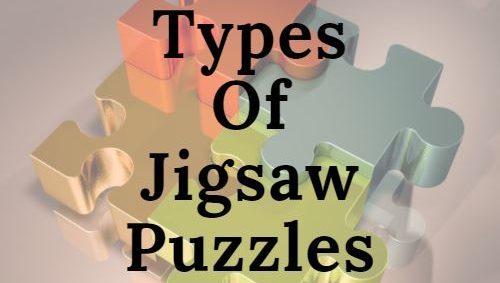Types Of Jigsaw Puzzle
Did you ever think about those vintage excavations and old-timey jigsaw puzzles you come across on the internet? Well, by now you must be thinking about the history of jigsaw puzzles. Let me tell you that the pioneer of jigsaw puzzle making is a man named John Spilsbury and this happened in the mid-sixties of the eighteenth century. In this article below we will look into the criteria for classifying different jigsaw puzzles and various types of jigsaw puzzles.
Jigsaw puzzles in general are solved by sticking different pieces given in the puzzle to form one meaningful predetermined figure or an image. This type of puzzle is classified into different categories based on the material used to manufacture them, the number of dimensions used to design them, and the face used to curate them. We shall now look into each of them in detail.
Material used
The material used for curating a jigsaw puzzle has been evolving for a long time. A traditional and old-school jigsaw puzzle is designed and manufactured with wood. Later the makers used cardboard to design them keeping in mind the production costs and weight of it. And nowadays, we come across the much cheaper option, i.e; plastic. However, the market for plastic-made jigsaw puzzles is lower than the other two varieties. Let’s check out each of them.
1. Wooden Jigsaw
Wooden jigsaw puzzles are being used since the initial days of solving a jigsaw puzzle. Wood is used for a classic variety of jigsaw puzzles and is considered the most favorite variety for a typical jigsaw puzzle buff. A number of pieces of wood are carved into different shapes and groves that fit seamlessly into each other to form a perfect face of the puzzle. In the beginning, it took a lot of hard work and manpower to make them. Today we have upgraded to the latest technology of using a laser beam to cut the pieces.
Wooden jigsaw puzzles weigh higher than the other two varieties and are also costlier. The difficulty level of a wooden jigsaw puzzle depends on the number of pieces involved or how complex the shapes are.
Here is an example of a wooden jigsaw puzzle.
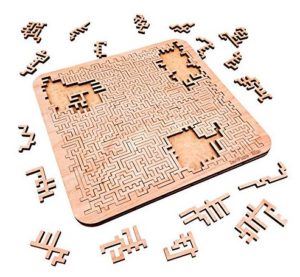
A number of wooden pieces cut into different pieces are given. You will be required to join all the pieces and fit them onto the wooden frame given.
2. Cardboard Jigsaw
A cardboard variety of jigsaw puzzles is cheaper than a wooden variety because shaping cardboard into different shapes requires less manpower and machinery, therefore it lowers the cost of production. Cardboard also weighs lower than wood therefore this makes it easier to carry them by people of any age group. The levels of difficulty depend on the same factors as they do with respect to the wood variety. However, one needs to be careful while carrying them and also to store them.
Here is an example of a cardboard jigsaw puzzle.
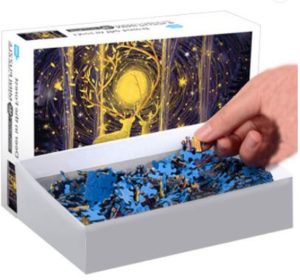
You will have to fix the cardboard pieces in order to form the image that is given on the top of the box.
3. Plastic Jigsaw
Plastic jigsaw puzzles are relatively less durable than the other two varieties. The durability depends on the quality of plastic used for designing the puzzle and the size of each puzzle piece. The size of the piece matters because, the smaller the piece, the more chances of breakage. Jigsaw puzzles manufactured with lower quality plastic can be used as a one-time activity for children at school or adults on a weekend just to have fun. A typical plastic jigsaw puzzle is not reliable for long time use as the pieces get folded or broken after using them a few times. The difficulty levels depend on the number of pieces, the image that you will be required to form, and the color variations in the pieces.
Here is an example of a plastic jigsaw puzzle.
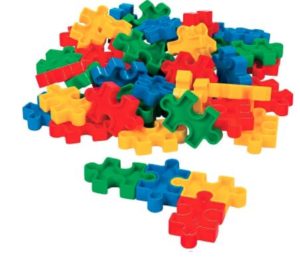
You will be required to fix all the given pieces of the puzzle made with plastic to form a specific figure.
Dimensions
Jigsaw puzzles are also subdivided into two categories based on the dimensions involved in solving the puzzle and the space used by the solver. The two types are two-dimensional and three-dimensional. Let us look into the details of each of them.
1. 2D Jigsaw
A two-dimensional jigsaw puzzle is flat. As the name reveals, this type of jigsaw puzzle can be solved on the floor, making it a two-dimensional variety. The price range assigned to manufacture this kind of puzzle differs according to the material used to make them, the number of pieces, the size of the pieces, the size of the puzzle, etc. In simple terms, the regular jigsaw puzzle that you have been using all your life is a 2D jigsaw puzzle. The levels of difficulty depend on the size of the puzzle and the number of pieces involved in it to solve.
Here is an example of a 2D jigsaw puzzle.
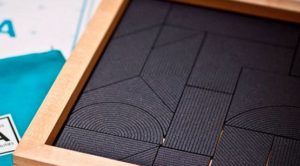
Different pieces in different shapes are given, and you will have to glue them together to fit them all into the wood frame that is given.
2. 3D Jigsaw
A three-dimensional jigsaw puzzle requires a space to solve. This type of jigsaw puzzle forms a 3D figure after you fix all the puzzle pieces together. The material used for manufacturing this type of puzzle is usually wood or high-quality plastic. Pieces made with lower quality plastic are prone to breakage after just a few use. The levels of difficulty depend on the same factors that are mentioned in the 2D variety of jigsaw puzzles.
Here is an example of a 3D jigsaw puzzle.
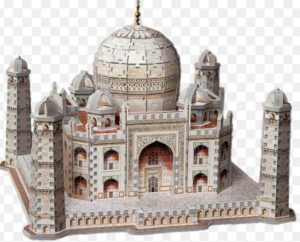
This is a difficult one!! I call it difficult because the number of pieces is very high and the structure is complex enough to make this difficult for you to solve.
Face
The classification of jigsaw puzzles also depends on the face of the puzzle. Depending on the face of a jigsaw puzzle, there are 6 variants. They are custom image, paintings, glow in the dark, colouring, murder mystery, gradient jigsaw.
1. Custom Image Jigsaw
For a custom image jigsaw puzzle, a set of blank pieces of the jigsaw puzzle is taken. All the pieces are set to form a defined geometrical figure, an image or a picture of one’s choice can be printed onto the puzzle. Then the puzzle is dismantled to make an unsolved jigsaw puzzle. The user is required to solve it as a regular jigsaw puzzle to form the image that you have chosen to be printed as the face of it. In simple terms, custom image jigsaw puzzle are curated with the face of your choice. The difficulty level depends on the color tones of the picture you choose and the number of pieces in the puzzle.
Here is an example of a custom image jigsaw.

The image you choose can be printed onto the pieces.
2. Painting Jigsaw
You must have come across different jigsaw puzzles that require you to fix all the given pieces to form a painting or beautiful scenery of one of the finest artists of the world. This variety comes under the painting jigsaw puzzles. The process of manufacturing them and the variations in the levels of difficulty are similar to those of the custom image jigsaw puzzle.
Here is an example of a painting jigsaw puzzle.
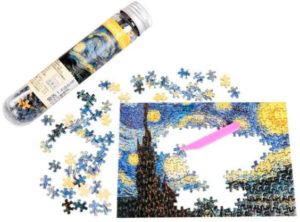
In this example, there are a number of pieces that require you to fix them all and form one of the famous works of Van Gogh, i.e; The Starry Night that was made in 1889.
3. Glow In The Dark Jigsaw
As the name reveals, the Glow in the Dark variety of jigsaw puzzles, glow when there is darkness around. Wondering what is used to make these puzzles glow? A special ink named luminescent ink is used in the manufacturing of this type of jigsaw puzzle. The ink absorbs the sunlight or even artificial light and the puzzles glow when they are kept in darkness. Vibrant and fluorescent colors are used to design them so that they look attractive in dark. To make the most out of solving the glow-in-the-dark jigsaw puzzles, make sure to sit in an ample amount of light so the light gets absorbed by the ink. Once you finish solving it, keep the solved puzzle in the darkness. The difficulty level differs like any other variety of a jigsaw puzzle.
Here is an example of a glow-in-the-dark jigsaw puzzle.
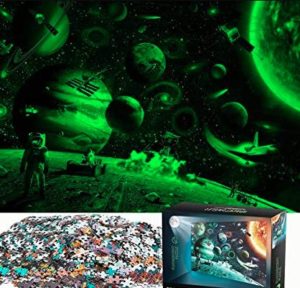
This a jigsaw puzzle made using1000 pieces, with outer space as its theme.
4. Colouring Jigsaw
Do you feel nostalgic about coloring different pictures during childhood or about solving jigsaw puzzles with family and friends? Well, it’s time to revive those memories and relive them. This category of jigsaw puzzles, i.e; the coloring jigsaw can be used for both activities at a time. You will be required to first fix all the given pieces of a jigsaw puzzle and then to color the face of the puzzle wither with the colors of your choice or a reference image is provided for you.
Here is an example of a coloring jigsaw.
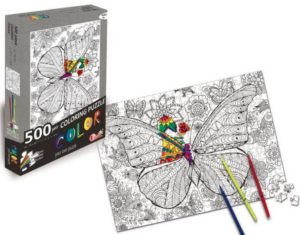
This is an example of a coloring jigsaw puzzle, made with 500 pieces. Once you solve the jigsaw puzzle, you will be required to color the butterfly image that is on the face of the puzzle.
5. Murder Mystery Jigsaw
This one is for you if you are a mystery buff and also a lover of solving jigsaw puzzles with family members on a long weekend. A murder mystery jigsaw is a type of jigsaw puzzle that requires you to solve a murder mystery using the solved jigsaw puzzle as a shred of important evidence. You are provided with two sets of jigsaw puzzles that look quite similar to each other. Once you solve both of them, you will have to read a booklet regarding the murder that took place. Based on the story in the booklet and the jigsaw puzzles you solved, unravel the mystery.
Here is an example of a murder mystery jigsaw puzzle.
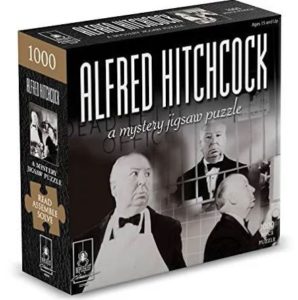
This is made with 1000 pieces and the manufacturer used the story of one of the most iconic mystery filmmakers, Alfred Hitchcock. Solve them and find the mystery behind the murder that took place in the story.
6. Gradient Jigsaw
A gradient jigsaw puzzle is considered the toughest among all the subcategories of jigsaw puzzles. It is because this variety is manufactured with a large number of pieces and the pieces that comprise a major chunk of the puzzle look similar to each other. A spectrum of colors is used as the face of the puzzle, and you will have to make sure to solve the puzzle according to the gradient of colors used in it. Here is a tip for you!! Firstly sorting all the pieces according to the color tones can help you save a little time.
Here is an example of a gradient jigsaw puzzle.
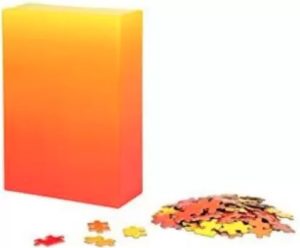
This is a gradient jigsaw puzzle made using the tones of yellow to orange. All the best and make sure to follow the tip!!
Conclusion:
Wondered after looking into the details and types of jigsaw puzzles? Well, the types mentioned above are only the most popular ones. With evolving needs of entertainment and methods that come in handy for stress relief, the latest technologies and varieties of manufacturing jigsaw puzzles are increased day by day. Make sure to look into each of them and try them all for various purposes like having fun, conducting an engaging activity at school for your students, or just relieving your stress.

